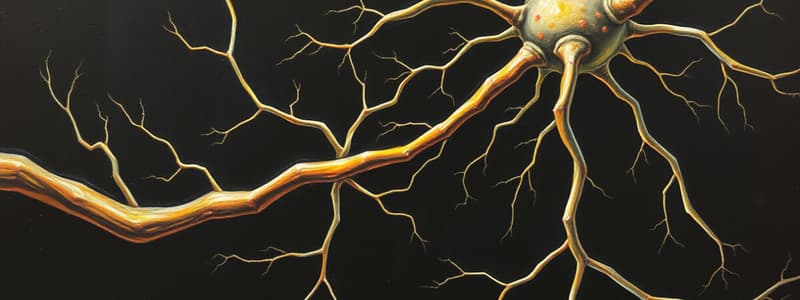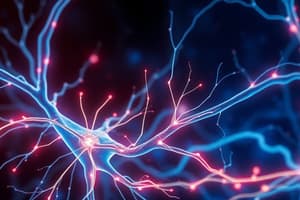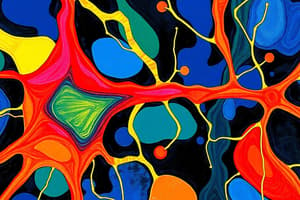Podcast
Questions and Answers
What is the primary role of acetylcholine at the neuromuscular junction?
What is the primary role of acetylcholine at the neuromuscular junction?
- To bind with nicotinic receptors and trigger muscle contraction (correct)
- To store calcium ions for muscle contraction
- To initiate the muscle relaxation process
- To conduct electrical impulses through the synaptic cleft
Which component of the neuromuscular junction is responsible for releasing acetylcholine?
Which component of the neuromuscular junction is responsible for releasing acetylcholine?
- Synaptic cleft
- Subneural cleft
- Postsynaptic membrane
- Presynaptic membrane (correct)
What phenomenon occurs when the postsynaptic membrane experiences an influx of sodium ions?
What phenomenon occurs when the postsynaptic membrane experiences an influx of sodium ions?
- Formation of end plate potential (correct)
- Activation of the acetylcholinesterase enzyme
- Development of action potential in opposite direction
- Decrease in muscle contraction efficiency
What condition must be met for an action potential to be triggered in the muscle fiber?
What condition must be met for an action potential to be triggered in the muscle fiber?
What is located in the synaptic cleft that helps in breaking down acetylcholine?
What is located in the synaptic cleft that helps in breaking down acetylcholine?
What is the characteristic of the end plate potential?
What is the characteristic of the end plate potential?
Which of the following statements about miniature end plate potential is correct?
Which of the following statements about miniature end plate potential is correct?
Which structure is lined with receptors for acetylcholine on the neuromuscular junction?
Which structure is lined with receptors for acetylcholine on the neuromuscular junction?
Flashcards are hidden until you start studying
Study Notes
Neuromuscular Junction
- The motor end plate serves as the synapse between motor neuron axons and skeletal muscle.
- This structure is classified as a chemical synapse.
Components of Neuromuscular Junction
- Synaptic knobs: Contain mitochondria and vesicles filled with acetylcholine.
- Presynaptic membrane: Features synapsin proteins critical for synaptic function.
- Synaptic cleft: Contains extracellular fluid and the enzyme acetylcholinesterase, which breaks down acetylcholine.
- Postsynaptic membrane: Includes a subneural cleft and receptors that bind acetylcholine.
Steps of Neuromuscular Transmission
- An action potential triggers the opening of voltage-gated calcium channels.
- Calcium ions influx into the presynaptic neuron, leading to vesicle rupture and the release of acetylcholine.
- Acetylcholine diffuses across the synaptic cleft and binds to nicotinic receptors, forming the acetylcholine-receptor complex.
- This binding opens ligand-gated sodium channels, resulting in sodium ion influx.
- Localized positive potential change develops into an end plate potential, which can generate a muscle action potential and initiate muscle contraction.
Endplate Potential
- The resting membrane potential (RMP) of the postsynaptic membrane ranges from -80 to -90 mV.
- Sodium ion influx causes a localized change known as the end plate potential, which is not propagated and does not follow the All or None Law.
- If the end plate potential reaches a threshold of -60 mV, it triggers an action potential in the muscle fiber.
Miniature Endplate Potential
- At rest, small quantities of acetylcholine are released from nerve terminals.
- Each vesicle's release can produce a weak end plate potential of about 0.5 mV, known as the miniature end plate potential.
Studying That Suits You
Use AI to generate personalized quizzes and flashcards to suit your learning preferences.



